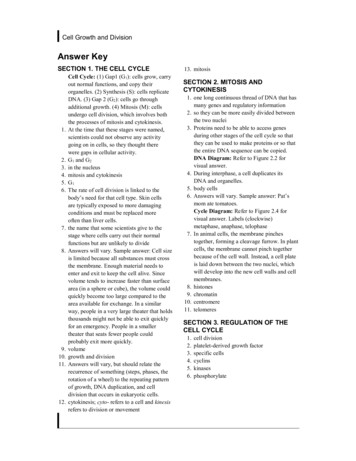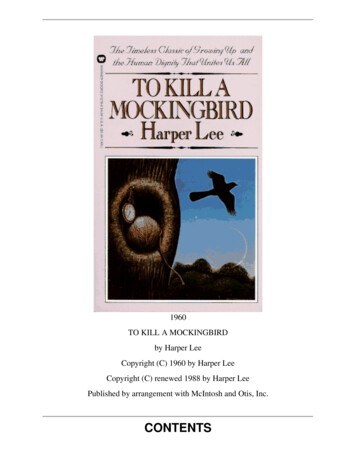
Transcription
Cell Growth and DivisionAnswer KeySECTION 1. THE CELL CYCLE1.2.3.4.5.6.7.8.9.10.11.12.Cell Cycle: (1) Gap1 (G1): cells grow, carryout normal functions, and copy theirorganelles. (2) Synthesis (S): cells replicateDNA. (3) Gap 2 (G2): cells go throughadditional growth. (4) Mitosis (M): cellsundergo cell division, which involves boththe processes of mitosis and cytokinesis.At the time that these stages were named,scientists could not observe any activitygoing on in cells, so they thought therewere gaps in cellular activity.G1 and G2in the nucleusmitosis and cytokinesisG1The rate of cell division is linked to thebody’s need for that cell type. Skin cellsare typically exposed to more damagingconditions and must be replaced moreoften than liver cells.the name that some scientists give to thestage where cells carry out their normalfunctions but are unlikely to divideAnswers will vary. Sample answer: Cell sizeis limited because all substances must crossthe membrane. Enough material needs toenter and exit to keep the cell alive. Sincevolume tends to increase faster than surfacearea (in a sphere or cube), the volume couldquickly become too large compared to thearea available for exchange. In a similarway, people in a very large theater that holdsthousands might not be able to exit quicklyfor an emergency. People in a smallertheater that seats fewer people couldprobably exit more quickly.volumegrowth and divisionAnswers will vary, but should relate therecurrence of something (steps, phases, therotation of a wheel) to the repeating patternof growth, DNA duplication, and celldivision that occurs in eukaryotic cells.cytokinesis; cyto- refers to a cell and kinesisrefers to division or movement13. mitosisSECTION 2. MITOSIS ANDCYTOKINESIS1. one long continuous thread of DNA that hasmany genes and regulatory information2. so they can be more easily divided betweenthe two nuclei3. Proteins need to be able to access genesduring other stages of the cell cycle so thatthey can be used to make proteins or so thatthe entire DNA sequence can be copied.DNA Diagram: Refer to Figure 2.2 forvisual answer.4. During interphase, a cell duplicates itsDNA and organelles.5. body cells6. Answers will vary. Sample answer: Pat’smom ate tomatoes.Cycle Diagram: Refer to Figure 2.4 forvisual answer. Labels (clockwise)metaphase, anaphase, telophase7. In animal cells, the membrane pinchestogether, forming a cleavage furrow. In plantcells, the membrane cannot pinch togetherbecause of the cell wall. Instead, a cell plateis laid down between the two nuclei, whichwill develop into the new cell walls and cellmembranes.8. histones9. chromatin10. centromere11. telomeresSECTION 3. REGULATION OF THECELL CYCLE1.2.3.4.5.6.cell divisionplatelet-derived growth factorspecific cellscyclinskinasesphosphorylate
Study Guide B continued7. cell division8. programmed cell death9. cancerConcept Mapa. tumorsb. benignc. malignantd. metastases10. Mutations may be inherited, caused bychemicals and radiation, and carried byviruses.11. to spread and grow by breaking awayfrom a tumor12. carcinogen13. Answers will vary.SECTION 4. ASEXUALREPRODUCTION1. Asexual reproduction produces geneticallyidentical offspring. Sexual reproductionproduces genetically unique offspring.2. The bacterial chromosome is copied.Both copies attach to the cell membrane.3. As the cell elongates, the chromosomesseparate.4. The membrane is pinched inward and anew wall is laid down. Refer to the VisualVocab in Section 4.5. Advantages: Asexual reproduction can bemore efficient under ideal circumstances.Disadvantages: Population may lack varietyto survive in changing conditions.6. Advantages: All organisms can potentiallyreproduce. Disadvantages: Not necessarilymore efficient than sexual reproduction.7. Advantages: No need to find a mate; nowasted energy attracting a mate.Disadvantages: Identical offspring allrespond in same way to environment.8. The two are genetically identical.9. simpler plants and animals10. budding, fragmentation, vegetativereproduction11. sexually and asexually by dividing in half orbreaking off small pieces from its base12. Answers will vary. Students shouldrecognize that “bi” indicates two. Binaryfission is the division of a single-celledorganism into two roughly equal parts.13. asexual reproductionSECTION 5. MULTICELLULAR an systemsphotosynthetic tissue; conductive tissue(e.g., xylem); protective tissueshoot system; root systemThese systems help organisms carry outcomplex, specialized functions and maintainhomeostasis.cell differentiationNo. All cells have the same DNA, butdifferent types of cells express differentsets of genes.The location helps determine how the cellwill differentiate.Concept map:a. originb. totipotentc. pluripotentd. multipotente. embryonicdivide and renew themselves for longperiods of time; remain undifferentiated inform; develop into a variety of specializedcell typesAdult stem cells could avoid rejectionissues and does not raise as many ethicalconcerns. Embryonic stem cells can developinto virtually any type of cell and can begrown indefinitely in culture.the process by which an unspecialized cellbecomes specializedorgan system, organ, tissue, cell
Section 1: The Cell CycleKEY CONCEPTCells have distinct phases of growth, reproduction, and normal functions.VOCABULARYcell cyclecytokinesismitosisMAIN IDEA: The cell cycle has four main stages.Summarize what happens during each stage of the cell cycle in the boxes below.G11. How did the G1 and G2 stages get their names?2. Cells must pass through a critical checkpoint during which two stagesof the cell cycle?3. Where does DNA synthesis happen in eukaryotic cells?4. What two processes make up the M stage?
Study Guide continuedMAIN IDEA: Cells divide at different rates.5. Among different types of cells, which stage of the cell cycle varies mostin length?6. Why does a skin cell divide more often than a liver cell?7. What is G0?RESEARCH QUESTION!!! MAIN IDEA: Cell size is limited.8. Write an analogy to explain why cell size is limited.9. Which typically increases faster as a cell grows, surface area or volume?10. For cells to stay the same size from generation to generation, what two thingsmust be coordinated?Vocabulary Check11. Think of an example of a cycle. What does this cycle have in common with thecell cycle?12. What process divides a cell’s cytoplasm? How do the two word parts of youranswer help you remember it?13. What process divides the cell nucleus and its contents?
Section 2: Mitosis and CytokinesisStudy GuideKEY CONCEPTCells divide during mitosis and chromatidMAIN IDEA: Chromosomes condense at the start of mitosis.1. What is a chromosome?2. Why do chromosomes condense at the start of mitosis?3. Why are chromosomes not condensed during all stages of the cell cycle?Refer to Figure 2.2 to sketch how DNA goes from a long stringy form to a tightlycondensed form. Label the parts of the condensed, duplicated chromosome.
Study Guide continuedMAIN IDEA: Mitosis and cytokinesis produce two genetically identicaldaughter cells.4. How does interphase prepare a cell to divide?5. Mitosis occurs in what types of cells?6. Develop a device, such as a short sentence or phrase, to help you rememberthe order of the steps of mitosis: prophase, metaphase, anaphase, telophase.Complete the diagram illustrating the four phases of mitosis and one phaseof cytokinesis.ProphaseCytokinesis7. How does cytokinesis differ between plant and animal cells?Vocabulary Check8. DNA wraps around organizing proteins called .9. The suffix -tin indicates that something is stretched and thin.is the loose combination of DNA and proteins that looks sort of like spaghetti.10. Sister chromatids are held together at the , which looks pinched.11. The ends of DNA molecules form structures called that helpprevent the loss of genes.
Section 3: Regulation of the Cell CycleStudy GuideKEY CONCEPTCell cycle regulation is necessary for healthy growth.VOCABULARYgrowth cinogenRESEARCH QUESTION - MAIN IDEA: Internal and external factors regulate celldivision.Complete the concept map below to show important ideas about growth factors.manycell rythropoietinUse the word bank to complete the sequence diagram below.kinasescell cyclins5.result in7.8. What is apoptosis?
Study Guide continuedMAIN IDEA: Cell division is uncontrolled in cancer.9. What type of disease may result if cell division is not properly regulated?Complete the concept map below about cancer cells.Cancer cellsforma.e.g.b.e.g.c.results ind.10. List three ways mutations can occur in genes involved in cell-cycle regulation.Vocabulary Check11. What does metastasize mean?12. What is a substance known to produce or promote the development of cancer?13. Draw a cartoon to help you remember the difference between benign andmalignant.
Section 4: Asexual ReproductionStudy GuideKEY CONCEPTMany organisms reproduce by cell division.VOCABULARYasexual reproductionbinary fissionMAIN IDEA: Binary fission is similar in function to mitosis.1. Offspring resulting from asexual reproduction and those resulting from sexualreproduction differ in one major way. What is the difference?Sketch the steps of binary fission in the boxes below. Beside each sketch, write abrief description of what is occurring.2.3.4.
Study Guide continuedFill in chart below to highlight the advantages and disadvantages of AIN IDEA: Some eukaryotes reproduce through mitosis.8. If a eukaryotic organism reproduces through mitosis, what is true about theoffspring and the parent organism?9. In what types of organisms is mitotic reproduction most common?10. List three examples of mitotic reproduction.11. What forms of reproduction does the sea anemone use?Vocabulary Check12. Write a word that starts with the letters “bi.” Explain what is similar betweenthe meaning of the word you wrote and the meaning of “binary fission.”13. What is the creation of offspring from only one parent organism called?
Section 5: Multicellular LifeStudy Guide BKEY CONCEPTCells work together to carry out complex functions.VOCABULARYtissueorgan systemorgancell differentiationstem cellMAIN IDEA: Multicellular organisms depend on interactions among different celltypes.Complete the diagram below that represents organization in up4. List two examples of tissues found in plants.5. List two examples of organ systems found in plants.6. How does an organism benefit from organ systems that work together andcommunicate?MAIN IDEA: Specialized cells perform specific functions.7. What is the process by which unspecialized cells develop intospecialized cells?8. Do different types of cells have different DNA? Explain.9. What role does cell location play within a developing embryo?
Study Guide continuedSPECIAL TOPIC --- MAIN IDEA: Stem cells can develop into different cell types.Complete the concept map below about stem cell classification.Stem cellscan be classified bypotentiale.g.b.e.gc.a.e.g.e.g.adulte.g.d.e.10. List the three identifying characteristics of stem cells.11. List one advantage of using adult stem cells and one advantage of usingembryonic stem cells.Vocabulary Check12. What is cell differentiation?13. Write the following words in order from the largest structure to the smalleststructure: cell, organ, organ system, tissue
6wxg\ *xlgh frqwlqxhg 0 ,1 ,'( 0lwrvlv dqg f\wrnlqhvlv surgxfh wzr jhqhwlfdoo\ lghqwlfdo gdxjkwhu fhoov rz grhv lqwhuskdvh suhsduh d fhoo wr glylgh"











